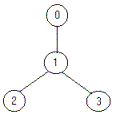Strategic game
Description
Bob enjoys playing computer games, especially strategic games, but sometimes he cannot find the solution fast enough and then he is very sad. Now he has the following problem. He must defend a medieval city, the roads of which form a tree. He has to put the minimum number of soldiers on the nodes so that they can observe all the edges. Can you help him?
Your program should find the minimum number of soldiers that Bob has to put for a given tree.
For example for the tree:

the solution is one soldier (at the node 1).
Input
The input file contains several data sets in text format. Each data set represents a tree with the following description:the number of nodes the description of each node in the following format:The node identifiers are integer numbers between 0 and n-1, for n nodes ( 0 < n ≤ 1500). Every edge appears only once in the input data.
node_identifier:(number_of_roads) node_identifier1 node_identifier2 ? node_identifiernumber_of_roads
or
node_identifier:(0)
Output
The output should be printed on the standard output. For each given input data set, print one integer number in a single line that gives the result (the minimum number of soldiers).
Sample Input 4 0:(1) 1 1:(2) 2 3 2:(0) 3:(0) 5 3:(3) 1 4 2 1:(1) 0 2:(0) 0:(0) 4:(0)
題意:給定一棵樹,選擇盡量少的點,使得每個沒有選中的結點至少和一個已經選中的結點相鄰。輸出最少需要選擇的節點數。
#include
#include
#include
#include
#include
#include
#include
#include
#include
#include
#include
using namespace std;
const int MAXN = 1510;
int nx, ny;
int used[MAXN];
int cx[MAXN], cy[MAXN];
vectorg[MAXN];
int Find(int u)
{
for(int i = 0; i < g[u].size(); i++)
{
int v = g[u][i];
if(!used[v])
{
used[v] = 1;
if(cy[v]==-1 || Find(cy[v]))
{
cy[v] = u;
cx[u] = v;
return 1;
}
}
}
return 0;
}
int Hungary()
{
int res = 0;
memset(cx, -1, sizeof(cx));
memset(cy, -1, sizeof(cy));
for(int i = 0; i < nx; i++)
{
if(cx[i] == -1)
{
memset(used, 0, sizeof(used));
if(Find(i))
res++;
}
}
return res;
}
int main()
{
//freopen("in.txt", "r", stdin);
//freopen("out.txt", "w", stdout);
int t, n, num;
int x, y;
while(cin>>n)
{
if(!n)
break;
ny = nx = n;
t = n;
for(int i = 0; i < n; i++)
g[i].clear();
while(t--)
{
scanf("%d:(%d)", &x, &num);
while(num--)
{
scanf("%d", &y);
g[x].push_back(y);
g[y].push_back(x);
}
}
printf("%d\n", Hungary()/2);
}
return 0;
}